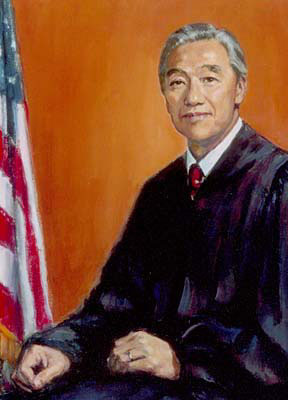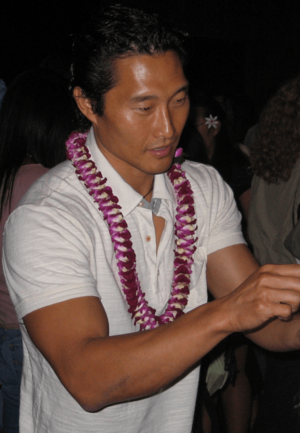Korean immigration to Hawaii facts for kids
| Total population | |
|---|---|
| 48,699 (2010) | |
| Regions with significant populations | |
| Languages | |
| English, Korean | |
| Religion | |
| Presbyterianism, Methodism, Buddhism |
Koreans have been moving to Hawaii for a long time, starting in the early 1900s. There were two main times when many Koreans moved: the first big group came between 1903 and 1949, and another group arrived from 1950 to 1964. On January 13, 2003, George W. Bush, who was the President of the United States, honored 100 years of Korean immigration. He recognized how much Korean Americans have helped the country.
Contents
First Koreans Arrive in Hawaii
The very first large group of Korean immigrants came to the United States on January 13, 1903. The Korean Empire had given them their first English-language passports the year before. They traveled on a ship called the RMS Gaelic and landed in Hawaii.
The people on the ship were from different age groups and backgrounds. Among them were fifty-six men who were hired to work on sugarcane plantations in the Territory of Hawaii. There were also twenty-one women and twenty-five children. Within two years of this first group, more than 7,000 Koreans had moved to Hawaii.
Why Koreans Moved to America
The first large group of Korean immigrants settled in America between 1901 and 1905. During these years, 7,226 immigrants arrived on 65 different trips. This group included 6,048 men, 637 women, and 541 children.
Many of these early immigrants had connections with American missionaries in Korea. Some Korean thinkers who liked Western ideas believed that moving to the United States would help them modernize their home country. Because of this, David Deshler, who was hiring workers for the Hawaiian Sugar Planters' Association (HSPA), easily found Koreans from many different social classes who wanted to sail to Hawaii.
According to Dr. Wayne Patterson, bringing Koreans to Hawaii went against U.S. laws about foreign workers. Deshler hired Koreans to replace Japanese workers who were on strike at the Hawaiian plantations. Some American business people, who had previously helped overthrow the Hawaiian Monarchy, worked with Dr. Horace Allen and Deshler. They found a way to get around the U.S. immigration laws to deal with the Japanese workers' strike. Many Koreans came to Hawaii from 1903 to 1905 through a plan that paid for their boat tickets, which broke the law. In some cases, the Koreans later had to pay back their travel money to the HSPA.
New Hopes and Challenges
Over one hundred years, the Korean population in America grew from about seven thousand to around two million people.
King Gojong (1852–1919) was the ruler of Korea when the first Koreans moved to America. He played an important part in the lives of Koreans living abroad. Christian missionaries came to Korea during King Gojong's time. By the 1890s, American missionaries were very important in spreading Christianity in Korea. Dr. Horace Allen, who was a missionary and later a diplomat, was involved in Korean politics and represented American trade. The missionaries brought not only Christianity but also new ideas about business, Western education, and Western culture. Many of the immigrants became Christians.
In Korea, Protestant Christianity was mainly Methodist and Presbyterian. These two Protestant groups decided not to do the same missionary work in the same places. They agreed that the Methodist mission in Hawai'i would help the Korean immigrants.
Korea's first official agreement with America was in May 1882. Before this treaty, there was a "little war" with bloody fights between the two countries. This less-known event in American history involved a strong American ship, the Colorado, entering Korean waters. Its soldiers landed on Ganghwa Island. A battle happened, and more than three hundred Koreans and three American soldiers were killed.
The Americans later returned to make a treaty. This led to the Treaty of Amity and Commerce in 1882. One part of this treaty allowed Koreans to move to America. The first group of immigrants came from the Methodist church of Rev. George Heber Jones in Jemulpo (now Inchon).
Early Korean Immigrants
- Before 1903: Records from Hawaii show there were sixteen Koreans in the Territory of Hawai'i in 1902. Some are said to have been ginseng merchants who came using Chinese passports. One of these merchants was Choo Eun Yang. He came to Hawai'i and then moved to San Francisco around 1898. He became active in the Korean community there, became successful, and lived to be 102 years old. Another immigrant, Sung Pong Chang, worked for the Circuit Court of Hawai'i and the Honolulu Police Department as an interpreter until he died in 1949.
- Four Famous Korean Immigrants: Some well-known Korean immigrants include Dr. Philip Jaisohn (1866–1951), Dr. Syngman Rhee (1875–1965), Dosan Ahn Chang Ho (1878–1938), and Young Man Pak (1877–1928). You can also find more in the List of notable Korean Americans in Hawaii.
Koreatown in Hawaii
Many Korean businesses are located on Keeaumoku Street. This area has earned the nickname "Koreamoku." Even though it hasn't been officially called a Koreatown, the State of Hawaii has thought about giving it that name in recent years.
Notable Korean Americans in Hawaii
Here are some important Korean Americans who have lived in Hawaii:
- Dr. Philip Jaisohn (1866–1951)
- Dr. Syngman Rhee (1875–1965)
- Young Man Pak (1877–1928)
- Herbert Young Cho Choy (born 1916, Makaweli, Hawaii–2004) was the first Asian American federal judge in U.S. history. He was also the first person of Korean background to become a lawyer in the United States.
- Daniel Dae Kim (born 1968) is a Korean American actor. He is famous for playing Jin-Soo Kwon on the TV show Lost and Chin Ho Kelly on Hawaii Five-0.
- Harry Kim was the mayor of Hawaii County, Hawaii, in the United States.
- Ronald Moon (Korean name: 문대양 born 1940) was the Chief Justice (the main judge) of the Hawaii State Supreme Court in Honolulu, Hawaii.
- Michelle Sung Wie (born 1989) is a Korean-American professional golfer. In 2006, Time magazine called her "one of 100 people who shape our world."
- Jay Dee "B.J." Penn (born 1978 in Kailua, Hawaii) is a Korean-American professional mixed martial arts (MMA) fighter and Jiu-Jitsu expert. He is a former Ultimate Fighting Championship lightweight champion.
See also
 In Spanish: Inmigración coreana en Hawái para niños
In Spanish: Inmigración coreana en Hawái para niños



